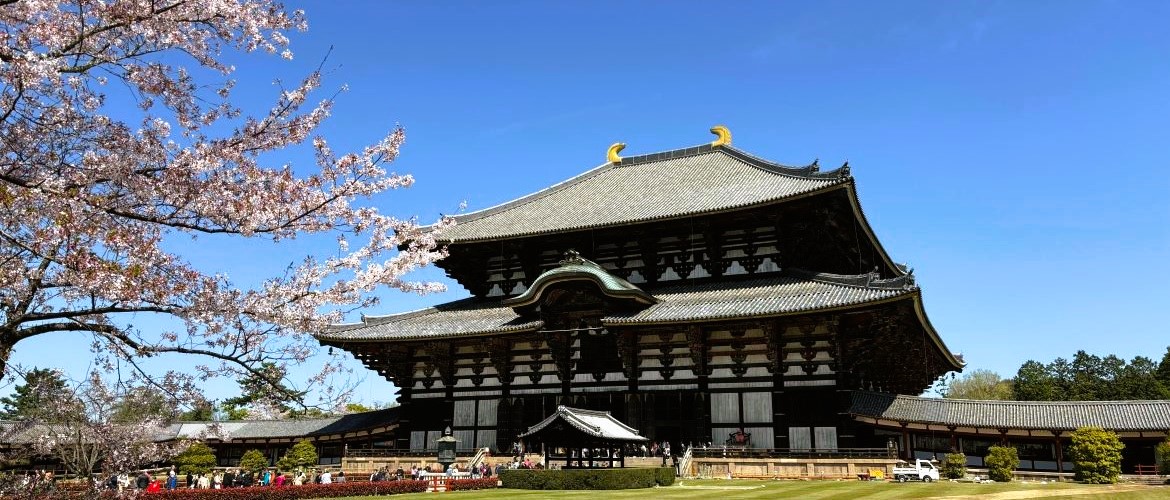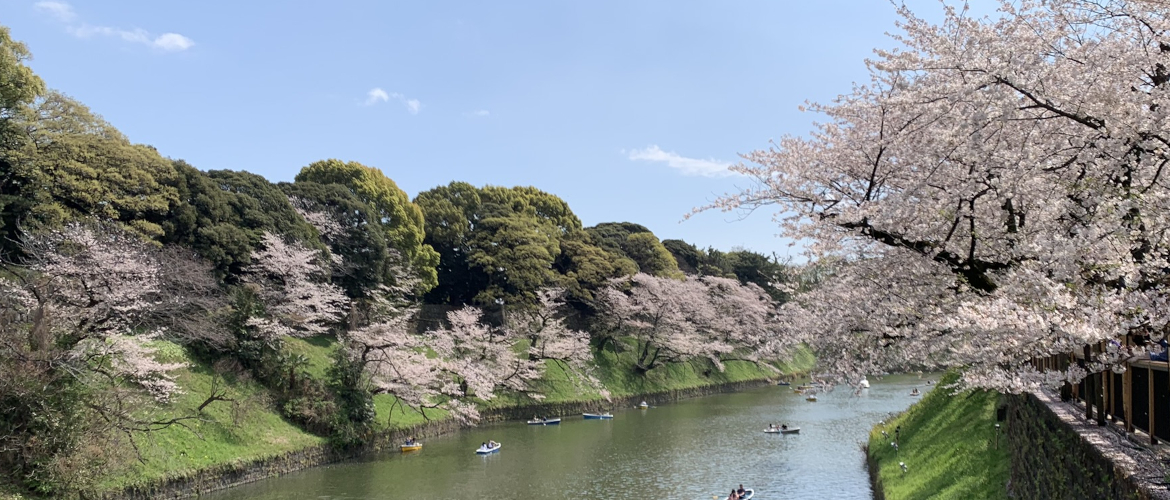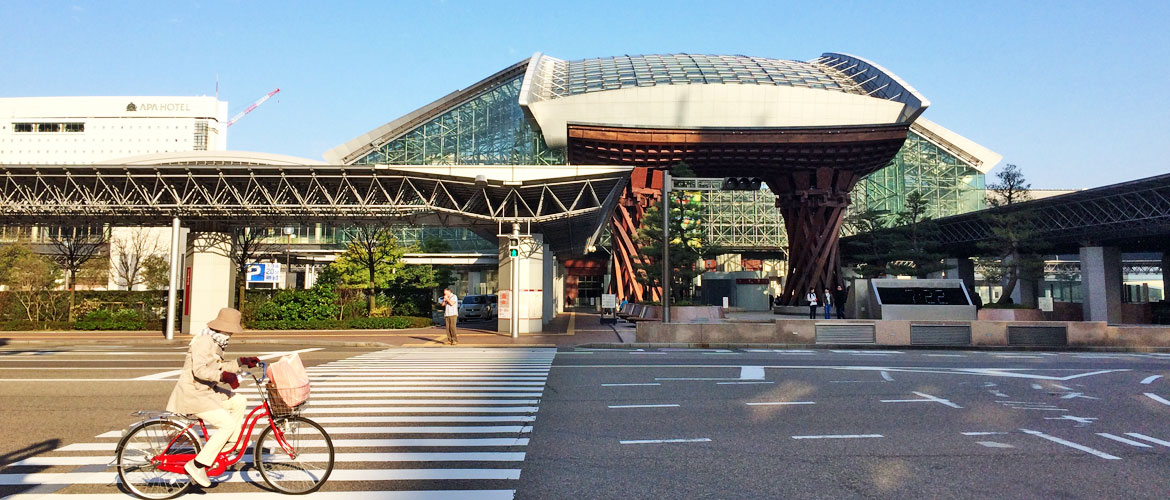
Tokyo – Kanazawa – Kyoto – Nara – Osaka
If you prefer to travel independently but hesitate to do so in Japan due to language and logistic barriers, this 12-day Semi-independent Japan Tour might be just for you. The itinerary includes guided service on some days but leaves most days for you to explore on your own.
The itinerary takes in Japan’s top three destinations, from which optional day tours to nearby attractions can be arranged on request.
FRIENDLY REMINDER
We travel between cities by train with reserved seats. Getting around in a city is mostly by public transit and walking, with occasional usage of taxi per itinerary. Participants must travel light and be able to walk 10 kilometres at a brisk pace every day.

Meal Code: B = breakfast
Day 1/Mon: Departing Home City
The journey begins with your transpacific flight departing from a city of your choice. You’ll lose a day upon crossing the International Date Line.
Day 2/Tue: Arrival in Tokyo
Welcome to Tokyo!
Please make your way to the hotel on your own. Detailed up-to-date information on how to get to the hotel will be provided in the final update two weeks before departure.
Day 3/Wed: Tokyo (B/L)
Tokyo, literally meaning “eastern capital” and officially named Tokyo Metropolis, is one of the most populous mega-cities in the world with a population of 14 million. Formerly known as Edo, the city has been the de facto seat of the Japanese government since 1603 when shogun Tokugawa Ieyasu chose the city for his headquarters. The shogun (general) was a hereditary commander ceremoniously appointed by the emperor but held real power over the country during the shogunate period between 1192 and 1867. Edo was renamed Tokyo after Emperor Meiji moved his seat from Kyoto in 1868 when the last shogun was forced to return power to the imperial court. The city covers an area of 2,187 square kilometres following the merger in 1943 of the city of Tokyo and Tokyo Prefecture.
Our full-day sightseeing on foot and by public transit begins at the plaza in front of the Imperial Palace. A stroll across the plaza accompanied by commentaries on the imperial family and the history of Tokyo gets the tour off to a good start.
We then proceed to Senso-ji, the oldest Buddhist temple in Tokyo dating back to 628.
After lunch, we visit Meiji Jingu, a Shinto shrine dedicated to Emperor Meiji (1852 -1912) and his wife.
We end the day with a visit to the observation deck atop the Tokyo Metropolitan Government Building in Shinjuku. On a clear day, the visitor could see the peak of Mount Fuji which is located about 84 km to the west. The building complex completed in 1990 at a cost of US$1 billion consists of three main structures each taking up a city block. The architect of the Tokyo Metropolitan Government Building is Kenzo Tange (1913 – 2005), who in 1987 became the first Japanese to win the Pritzker Prize for Architecture.
Day 4/Thu: Tokyo (B)
Free day to explore on your own.
We highly recommend Ginza and Akihabara shopping districts, which even non-shoppers should find exciting. Also recommended are the top-rated Tokyo National Museum and The National Museum of Western Art – both located at Ueno Park, one of Tokyo’s most popular locations for cherry blossom every spring.
Optional day tour to Mt. Fuji and Hakone may be available on request.
Day 5/Fri: Tokyo – Kanazawa (B)
Today we travel to Kanazawa by shinkansen high-speed train (Hakutaka #561, 11:24/14:17). Be sure to grab some snacks for lunch before getting on the train.
On the shores of the Sea of Japan, Kanazawa is the capital of Ishikawa Prefecture. The city has a population of 466,000 and is considered a jewel of Japanese tourism that is often overlooked by foreign tourists due to its relatively remote location. Travellers coming here are richly rewarded with the well-preserved Edo-period city, where the samurai, merchants, geisha, and daimyo (lords) all left their mark.
After hotel check-in, we walk 850 m (15 minutes) to Higashi Chaya district. This is one of the three preserved historical geisha districts in Kanazawa (along with Nishichayagai and Kazuemachi) where geisha still entertain today.
Day 6/Sat: Kanazawa (B/L)
Today’s sightseeing on foot begins at Omicho Market, Kanazawa’s largest fresh food market particularly well known for seafood.
From the market, Kanazawa Castle is just a few minutes away on foot. The restored castle was originally built in 1580 for Maeda Toshiie, the fourth son of a minor samurai who entered the service of a powerful daimyo (Oda Nobunaga) at the age of 15 and quickly rose through the ranks. The castle was reconstructed multiple times due to fire damages throughout its history. The last time a fire destroyed the castle was in 1881.
The Hishi Yagura turret, Gojikken Nagaya warehouse and the Hashizume-mon Tsuzuki Yagura turret were faithfully restored in 2001 to their 1809 form using traditional construction methods. Today’s pillars are constructed from the Japanese Hinoki cypress along with the use of the massive American cypress as ceiling beams. The reconstructed buildings feature roof tiles made of lead mixed with a little copper for the sake durability and aesthetics.
From the castle, we walk across a bridge to enter Kenroku-en, which used to be part of the castle. One of the “Three Great Gardens of Japan” (Koraku-en in Okayama and Kairaku-en in Mito being the other two), Kenroku-en was developed from the 1620s to the 1840s by the Maeda clan, the daimyo that ruled the former Kaga Domain.
Free afternoon to explore on your own. We recommend Nagamachi, a historical preservation zone where the residents still go about their daily lives among the remnants of a bygone age. A highlight of the neighbourhood is the restored Nomura Samurai House, whose small but supremely exquisite traditional garden delights visitors from around the world.
Day 7/Sun: Kanazawa (B)
Free day to explore on your own.
Optional day tour to Takayama and Shirakawa is available on request.
Day 8/Mon: Kanazawa – Kyoto (B/L)
This morning we ride the express train (Tsurugi 15, 09:54/10:36; Thunderbird #16, 10:40/11:39) to Kyoto.
Nicknamed “City of Ten Thousand Shrines”, Kyoto (literal translation: capital city) served as Japan’s capital for more than one thousand years before the imperial court moved to Tokyo in 1868 with the onset of the Meiji Restoration (1868 to 1912, a historical period associated with the emergence of Japan as a modernized nation). Kyoto is a scaled replica of the Chinese Tang Dynasty’s capital Chang’an, present-day Xi’an. The Tang Dynasty (618 – 907) was a golden era in Chinese history and a time when Japanese adoption of Chinese culture reached its peak. Kyoto today, with a population of 1.5 million, forms a major part of the Kyoto-Osaka-Kobe metropolitan area.
Our first stop after lunch is Kinkaku-ji (Temple of Golden Pavilion). This is a Zen Buddhist temple and one of 17 locations comprising the Historic Monuments of Ancient Kyoto World Heritage Site.
We then proceed to the Arashiyama (Storm Mountain) area where our sightseeing takes in Tenryu-ji Temple and the Bamboo Forest. Located on the western outskirts of Kyoto, Arashiyama is famous for its immense natural beauty as well as its historical and cultural prominence due to the large number of well-preserved ancient Buddhist temples.
Day 9/Tue: Kyoto (B)
Free day to explore on your own. We recommend Nijo Castle and Kiyomizu-dera (Buddhist temple).
Construction of Nijo Castle began in 1601 under the order of Tokugawa Ieyasu, founder of the Tokugawa shogunate, but was not completed until 1626 during the reign of Iemitsu, the third Tokugawa shogun and grandson of Ieyasu. The Tokugawa shogunate was headquartered in Edo, present-day Tokyo, and Nijo Castle was the shogun’s residence in Kyoto where the imperial court was located. Nijo Castle is also the site that witnessed the ending of the Tokugawa shogunate. In late 1867, the last shogun, Yoshinobu, announced in the castle his decision to return his power back to the emperor. This was a watershed moment that helped usher in the Meiji Restoration, which, in turn, led to Japan’s industrialization and fundamentally transformed the Japanese society.
Day 10/Wed: Kyoto (B)
Free day to explore on your own.
Our recommendations include Kyoto Imperial Palace, Fushimi Inari Shrine (good for hiking), Ginkaku-ji (Silver Pavilion Temple), Kyoto National Museum, and Gion – the famous geisha entertainment district.
Day 11/Thu: Kyoto – Nara – Osaka (B/L)
We depart for Nara early in morning by local commuter train. Upon arrival, visit the magnificent Todai-ji. This ancient Buddhist temple is well-known not only for its splendid architecture and the huge bronze statue of the Buddha in the main hall but also for the 1,200 wild deer roaming freely on the grounds of the temple.
Afterwards we continue on by commuter train to Osaka, where we visit the historic Osaka Castle and Osaka’s legendary shopping and entertainment district known as Dotonbori. Situated at the mouth of the Yodo River on Osaka Bay, Osaka is Japan’s third most populous city (after Tokyo and Yokohama) and plays a significant role in the Japanese economy. Osaka was once known as the “nation’s kitchen” because of its function as Japan’s rice trading centre during the Edo period.
Free afternoon to explore on your own.
Day 12/Fri: Osaka – Return Home (B)
The tour ends this morning. Transfer to the airport (Kansai or Itami) on your own either by airport limousine bus or airport express train. Check with your guide for the most economical and efficient way to get to the airport.

Hotel List
| City | Nights | Hotel | Category |
| Tokyo | 3 | Tokyo Dome Hotel | Premium /4 stars |
| Kanazawa | 3 | Mitsui Garden Kanazawa | Premium /4 stars |
| Kyoto | 3 | Hilton Garden Inn Shijo | Premium /4 stars |
| Osaka | 1 | Courtyard Shin-Osaka | Premium /4 stars |
Hotels are subject to change without notice.
Dates & Prices
|
Prices are per person based on double occupancy. Scroll down for price inclusions and exclusions. |
| Depart (Mon) |
Return (Fri) |
Land Only* CA$/US$ |
Single Supplement CA$/US$ |
| 2025 | |||
| 16-Jun | 27-Jun | $5,250/$3,750 | $1,470/$1,050 |
| 07-Jul | 18-Jul | $5,250/$3,750 | $1,470/$1,050 |
| 06-Oct | 17-Oct | $5,530/$3,950 | $1,890/$1,350 |
| 13-Oct | 24-Oct | $5,840/$4,170 | $1,890/$1,350 |
| 20-Oct | 31-Oct | $5,870/$4,195 | $1,890/$1,350 |
| 03-Nov | 14-Nov | $5,990/$4,280 | $1,960/$1,400 |
| 10-Nov | 21-Nov | $5,990/$4,280 | $1,960/$1,400 |
| 2026 | |||
| 23-Mar | 03-Apr | $5,990/$4,280 | $1,960/$1,400 |
| 30-Mar | 10-Apr | $5,990/$4,280 | $1,960/$1,400 |
| 06-Apr | 17-Apr | $5,990/$4,280 | $1,960/$1,400 |
| 13-Apr | 24-Apr | $5,990/$4,280 | $1,960/$1,400 |
| 20-Apr | 01-May | $5,990/$4,280 | $1,960/$1,400 |
* Land Only price does not include international air. Contact us for a fare quote.
|
Tour price includes:
|
Tour price does NOT include:
See Terms & Conditions for more information. |

Passport & Visa
Your passport needs to have at least one blank visa page and six months validity at the end of the tour.
If you are a tourist from Canada, the US, the UK, Australia and New Zealand, you do not need a visa to enter Japan as long as your stay is within 90 days.
Travel Health
Japan is a very clean country, where tap water is potable. Some may prefer to boil tap water to get rid of the possible smell of chlorine. Always carry a roll of toilet paper and a bottle of hand sanitizer. In general, public toilets in Japan do not provide paper towels for hand drying; many of them have no electric hand dryers either. You should carry a small towel as many Japanese do when going out. Footwear is often forbidden when you go indoors at temples, historical sites and traditional restaurants; please bring proper socks to keep your feet comfortable.
Local Currency & Credit Card
Japan: yen (JPY)
Withdrawing cash from local ATMs after arrival remains our recommended method of currency exchange. Keep your inventory of local currency low. Credit cards are widely accepted across Japan. For transactions over $50, you are advised to use a credit card.
Travel Insurance – When to Buy
Your deposit will be kept as credit if you cancel for any reason. The transferrable credit has no expiration date. Therefore, it may be unnecessary to spend $30 to $50 on cancellation insurance just to protect the deposit.
However, purchase of trip cancellation & emergency medical insurance is strongly advised when your balance is due. If you don’t have proper coverage, the loss can be devastating in case of cancellation before or after commencement of the booked trip or in case of a serious medical emergency during the trip. Please ask us for premium quotes when your balance due date is near.

